Spectrotemporal processing in spectral tuning modules of cat primary auditory cortex
- PMID: 22384036
- PMCID: PMC3288040
- DOI: 10.1371/journal.pone.0031537
Spectrotemporal processing in spectral tuning modules of cat primary auditory cortex
Abstract
Spectral integration properties show topographical order in cat primary auditory cortex (AI). Along the iso-frequency domain, regions with predominantly narrowly tuned (NT) neurons are segregated from regions with more broadly tuned (BT) neurons, forming distinct processing modules. Despite their prominent spatial segregation, spectrotemporal processing has not been compared for these regions. We identified these NT and BT regions with broad-band ripple stimuli and characterized processing differences between them using both spectrotemporal receptive fields (STRFs) and nonlinear stimulus/firing rate transformations. The durations of STRF excitatory and inhibitory subfields were shorter and the best temporal modulation frequencies were higher for BT neurons than for NT neurons. For NT neurons, the bandwidth of excitatory and inhibitory subfields was matched, whereas for BT neurons it was not. Phase locking and feature selectivity were higher for NT neurons. Properties of the nonlinearities showed only slight differences across the bandwidth modules. These results indicate fundamental differences in spectrotemporal preferences--and thus distinct physiological functions--for neurons in BT and NT spectral integration modules. However, some global processing aspects, such as spectrotemporal interactions and nonlinear input/output behavior, appear to be similar for both neuronal subgroups. The findings suggest that spectral integration modules in AI differ in what specific stimulus aspects are processed, but they are similar in the manner in which stimulus information is processed.
Conflict of interest statement
Figures

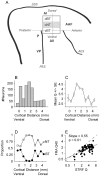
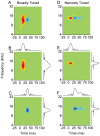
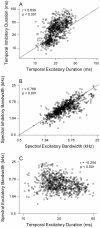

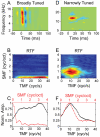
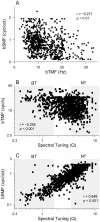


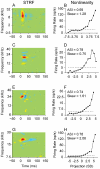

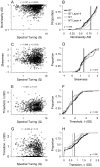
Similar articles
-
Functional congruity in local auditory cortical microcircuits.Neuroscience. 2016 Mar 1;316:402-19. doi: 10.1016/j.neuroscience.2015.12.057. Epub 2016 Jan 5. Neuroscience. 2016. PMID: 26768399 Free PMC article.
-
Nonlinear cross-frequency interactions in primary auditory cortex spectrotemporal receptive fields: a Wiener-Volterra analysis.J Comput Neurosci. 2010 Apr;28(2):285-303. doi: 10.1007/s10827-009-0209-8. Epub 2010 Jan 14. J Comput Neurosci. 2010. PMID: 20072806
-
Spectrotemporal receptive fields in the lemniscal auditory thalamus and cortex.J Neurophysiol. 2002 Jan;87(1):516-27. doi: 10.1152/jn.00395.2001. J Neurophysiol. 2002. PMID: 11784767
-
Spectrotemporal processing differences between auditory cortical fast-spiking and regular-spiking neurons.J Neurosci. 2008 Apr 9;28(15):3897-910. doi: 10.1523/JNEUROSCI.5366-07.2008. J Neurosci. 2008. PMID: 18400888 Free PMC article.
-
How do auditory cortex neurons represent communication sounds?Hear Res. 2013 Nov;305:102-12. doi: 10.1016/j.heares.2013.03.011. Epub 2013 Apr 17. Hear Res. 2013. PMID: 23603138 Review.
Cited by
-
Multidimensional receptive field processing by cat primary auditory cortical neurons.Neuroscience. 2017 Sep 17;359:130-141. doi: 10.1016/j.neuroscience.2017.07.003. Epub 2017 Jul 8. Neuroscience. 2017. PMID: 28694174 Free PMC article.
-
Information diversity in individual auditory cortical neurons is associated with functionally distinct coordinated neuronal ensembles.Sci Rep. 2021 Feb 18;11(1):4064. doi: 10.1038/s41598-021-83565-7. Sci Rep. 2021. PMID: 33603027 Free PMC article.
-
Functional congruity in local auditory cortical microcircuits.Neuroscience. 2016 Mar 1;316:402-19. doi: 10.1016/j.neuroscience.2015.12.057. Epub 2016 Jan 5. Neuroscience. 2016. PMID: 26768399 Free PMC article.
-
Developmental maturation of millimeter-scale functional networks across brain areas.Cereb Cortex. 2025 Feb 5;35(2):bhaf007. doi: 10.1093/cercor/bhaf007. Cereb Cortex. 2025. PMID: 39866127 Free PMC article.
-
The Essential Complexity of Auditory Receptive Fields.PLoS Comput Biol. 2015 Dec 18;11(12):e1004628. doi: 10.1371/journal.pcbi.1004628. eCollection 2015 Dec. PLoS Comput Biol. 2015. PMID: 26683490 Free PMC article.
References
Publication types
MeSH terms
Grants and funding
LinkOut - more resources
Full Text Sources
Research Materials
Miscellaneous

